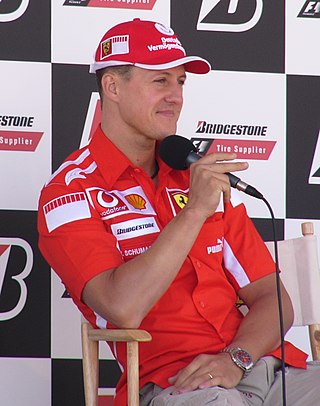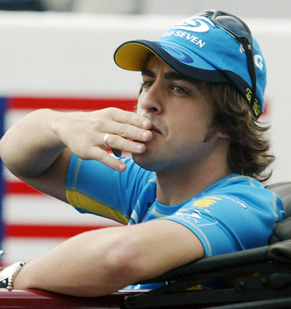
BMW has been involved in Formula One in a number of capacities since the inauguration of the World Drivers' Championship in 1950. The company entered occasional races in the 1950s and 1960s, before building the BMW M12/13 inline-four turbocharged engine in the 1980s. This engine was the result of a deal between BMW and Brabham, which resulted in the team's chassis being powered by BMW engines from 1982 until 1987, a period in which Nelson Piquet won the 1983 championship driving a Brabham BT52-BMW. BMW also supplied the M12/13 on a customer basis to the ATS, Arrows, Benetton and Ligier teams during this period, with various degrees of success. In 1988, Brabham temporarily withdrew from the sport and BMW withdrew its official backing from the engines, which were still used by the Arrows team under the Megatron badge. Turbocharged engines were banned by the revised Formula One Technical Regulations for 1989, rendering the M12/13 obsolete.

Renault, a French automobile manufacturer, has been associated with Formula One as both team owner and engine manufacturer for various periods since 1977. In 1977, the company entered Formula One as a constructor, introducing the turbo engine to Formula One with its EF1 engine. In 1983, Renault began supplying engines to other teams. Although the Renault team had won races, it withdrew at the end of 1985. Renault engines continued to be raced until 1986.

Peter Paul Sauber is a retired Swiss motorsport executive. He was the team principal and owner of various motorsports teams, most visibly the eponymous Sauber Formula One team.
Panasonic Toyota Racing was a Formula One team owned by the Japanese automobile manufacturer Toyota Motor Corporation and based in Cologne, Germany. Toyota announced their plans to join Formula One in 1999, and after extensive testing with their initial car, dubbed the TF101, the team made their debut in 2002. The new team grew from Toyota's long-standing Toyota Motorsport GmbH organisation, which had previously competed in the World Rally Championship and the 24 Hours of Le Mans. Despite a point in their first-ever race, Toyota never won a Grand Prix, their best finish being second, which they achieved five times.

The 2002 FIA Formula One World Championship was the 56th season of FIA Formula One motor racing. It began on 3 March and ended on 13 October after seventeen races.

Throughout its history, BMW cars and motorcycles have been successful in a range of motorsport activities. Apart from the factory efforts, many privateer teams enter BMW road cars in touring car racing. BMW also entered cars or provided engines in Formula One, Formula Two and sportscar racing. BMW is currently active in IMSA, the Isle of Man TT, the North West 200, the Superbike World Championship and the Deutsche Tourenwagen Masters.

Robert Józef Kubica is a Polish racing and rally driver, competing for Team WRT in the 2023 FIA World Endurance Championship. He was the first and, as of 2023, only Polish racing driver to compete in Formula One, making his latest appearance in the 2021 Italian Grand Prix.

The 2006 FIA Formula One World Championship was the 60th season of Formula One motor racing. It featured the 57th Formula One World Championship which began on 12 March and ended on 22 October after eighteen races. The Drivers' Championship was won by Fernando Alonso of Renault for the second year in a row, with Alonso becoming the youngest ever double world champion at the time. Then-retiring seven-time world champion Michael Schumacher of Scuderia Ferrari finished runner-up, 13 points behind. The Constructors' Championship was won by Renault, which defeated Ferrari by five points.

The 2007 FIA Formula One World Championship was the 61st season of FIA Formula One motor racing. It featured the 2007 FIA Formula One World Championship, which began on 18 March and ended on 21 October after seventeen events. The Drivers' Championship was won by Ferrari driver Kimi Räikkönen by one point at the final race of the season, making Räikkönen the third Finnish driver to take the title. An appeal by McLaren regarding the legality of some cars in the final race could have altered the championship standings, but on 16 November, the appeal was rejected by the International Court of Appeal, confirming the championship results. Räikkönen entered the final race in third position in the drivers' standings, but emerged as champion after the chequered flag, a feat first accomplished by Giuseppe Farina in 1950.
Sauber Motorsport AG is a Swiss motorsport engineering company. It was founded in 1970 by Peter Sauber, who progressed through hillclimbing and the World Sportscar Championship to reach Formula One in 1993. After operating under their own name from 1993 until 2005 then again from 2011 until 2018, Sauber Motorsport AG renamed their Formula One racing team to Alfa Romeo F1 Team in a partnership deal with Alfa Romeo from 2019 to 2023. Sauber is set to be the Audi factory team for the 2026 season onwards.

Max Welti is a former Swiss racing driver, Sauber's first team manager and thus double winner of the 24 Hours of Le Mans as well as two-time sports car world champion with Sauber Mercedes. Five years later, he wins the 24 Hours of Le Mans for a second time with Porsche as the responsible race director. He then returns to Sauber as overall manager of the Sauber Formula One operation. In 2000 Welti becomes CEO of the European silhouette touring car racing series "V8STAR" before becoming team owner of A1 A1 Team Switzerland in 2005. As an international motorsport strategist and consultant, Welti nowadays works for OEMs, promoters and organisers.
Mercedes AMG High Performance Powertrains is a Formula One engine manufacturer, owned by Mercedes-Benz.

The Williams FW27 was the Formula One car which the Williams team used during the 2005 Formula One season.

The BMW Sauber F1.06 was the car with which the BMW Sauber team competed in the 2006 Formula One World Championship. It was driven by German Nick Heidfeld, who joined from Williams, and Canadian Jacques Villeneuve, who had spent one season with Sauber before it was bought by BMW. However, Villeneuve was replaced by third driver, Pole Robert Kubica, before the season finished. The year marked the first time that BMW had competed as a full team; previously it had only supplied engines.
Formula One sponsorship liveries have been used since the 1968 season. Before the arrival of sponsorship liveries in 1968 the nationality of the team determined the colour of a car entered by the team. Major sponsors such as BP, Shell, and Firestone had pulled out of the sport ahead of this season, prompting the Fédération Internationale de l'Automobile to allow unrestricted sponsorship. Team Gunston became the first Formula One team to implement sponsorship brands as a livery on their Brabham car, which privately entered for John Love in orange, brown and gold colours of Gunston cigarettes in the first race of the 1968 season, the 1968 South African Grand Prix, on 1 January 1968. In the next race, the 1968 Spanish Grand Prix, Team Lotus became the first works team to follow this example, with Graham Hill's Lotus 49B entered in the red, gold and white colors of Imperial Tobacco's Gold Leaf brand. With rising costs in Formula One, sponsors becoming more important and thus liveries reflected the teams' sponsors.

The Sauber C22 was the car with which the Sauber Petronas team competed in the 2003 Formula One World Championship.
Jens Marquardt, is a German motor sports engineer and manager, most recently the business development manager of Toyota Motorsport GmbH.

The BMW E41 and P80 series is a family of naturally-aspirated Formula One racing engines, designed and developed by BMW, and introduced in 2000 in partnership with Williams, and continued through 2006, during their partnership with Sauber.














